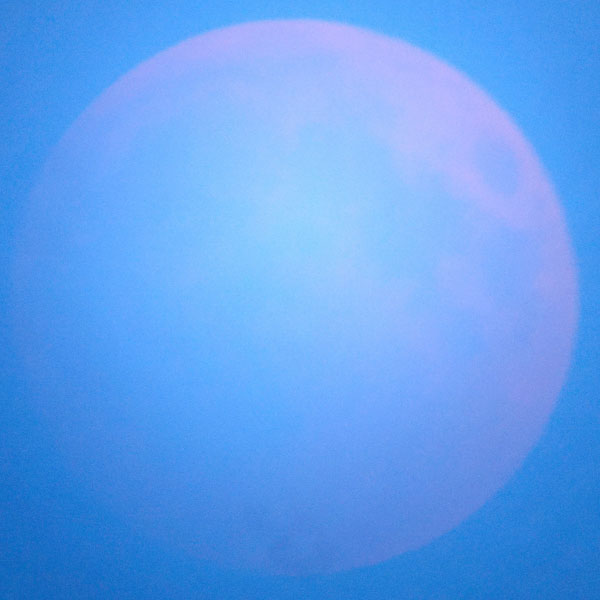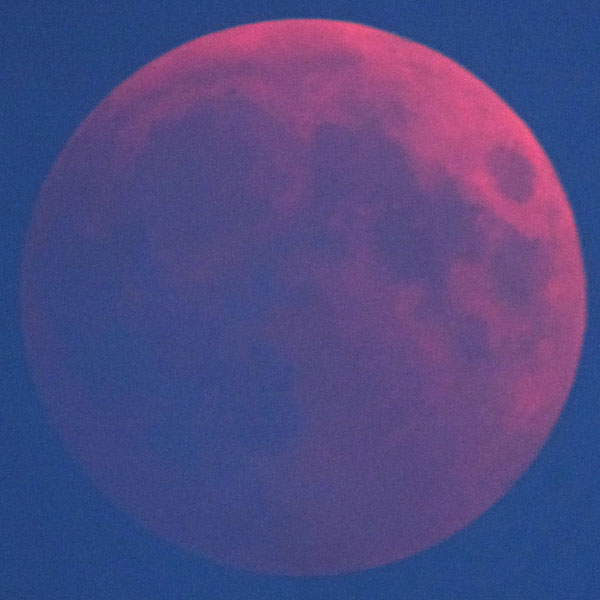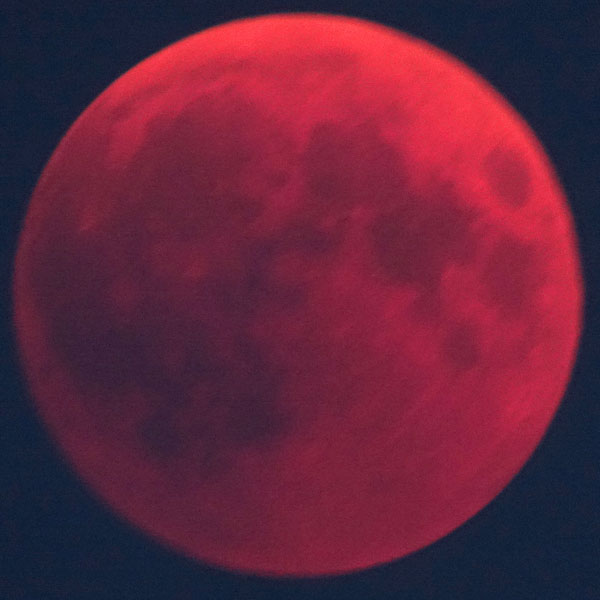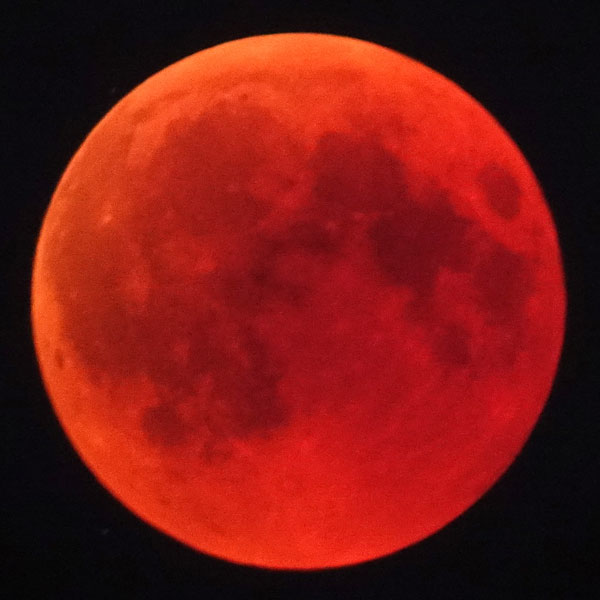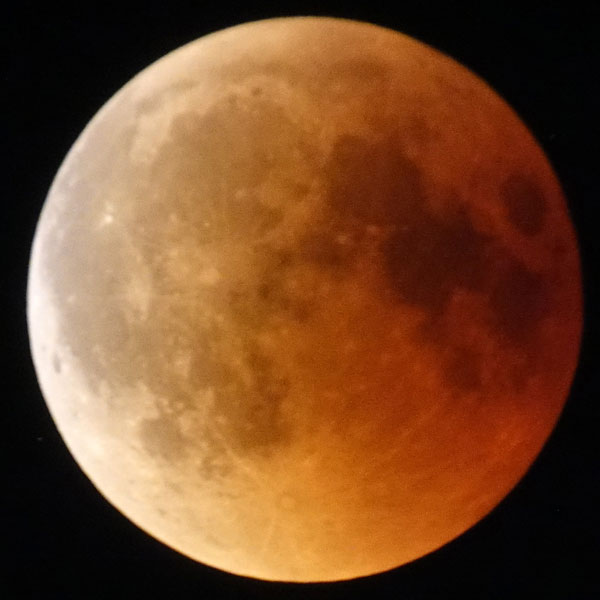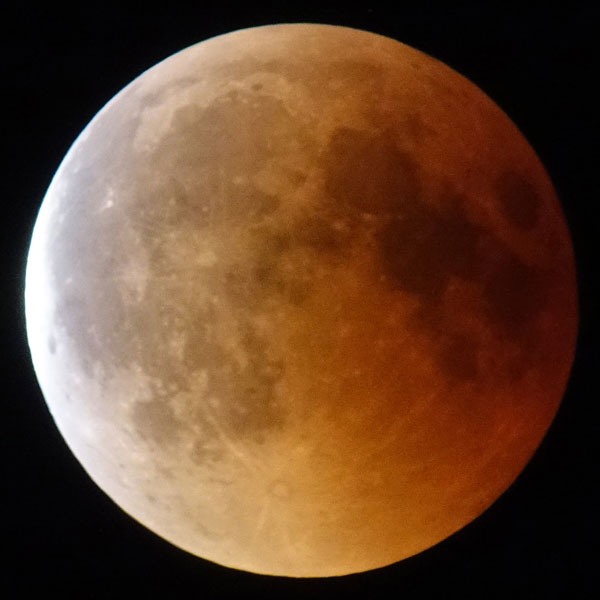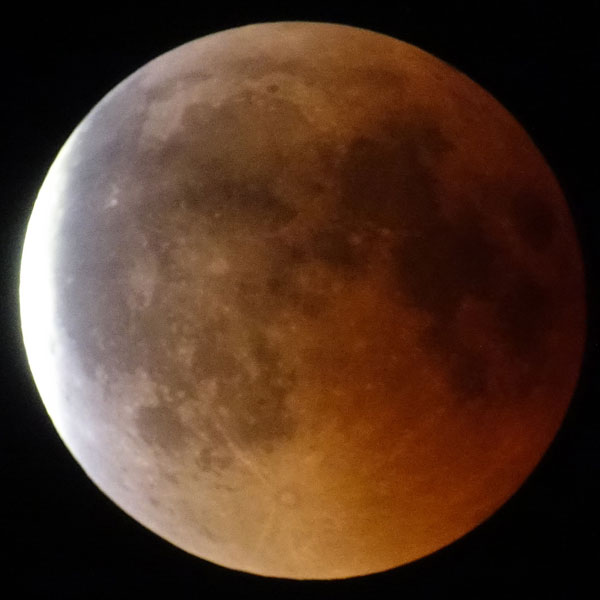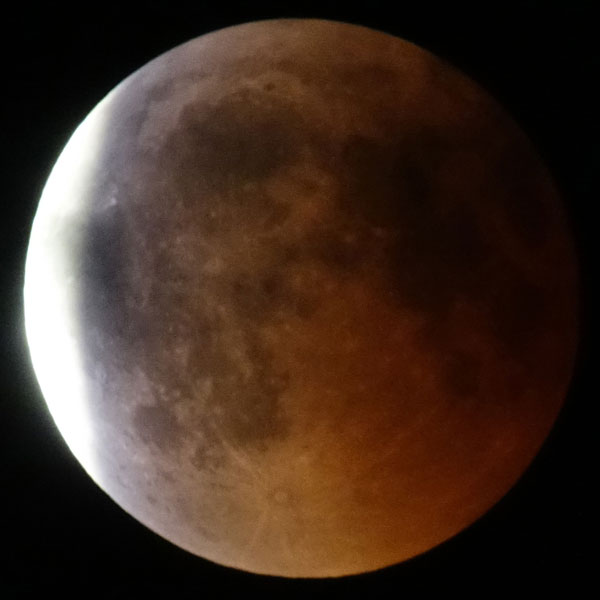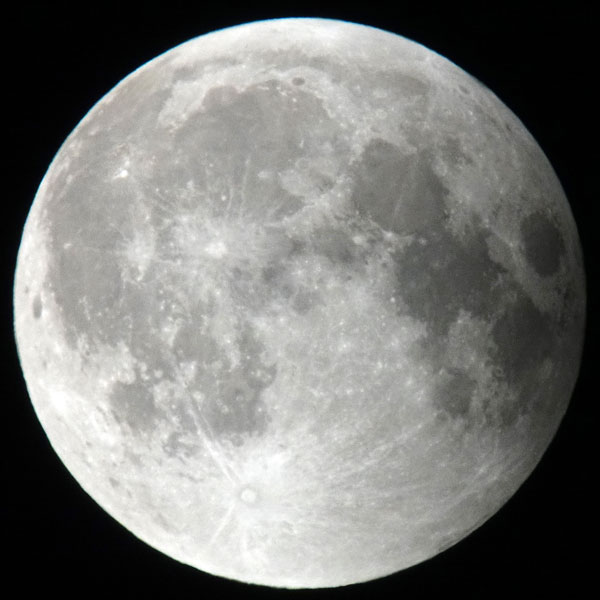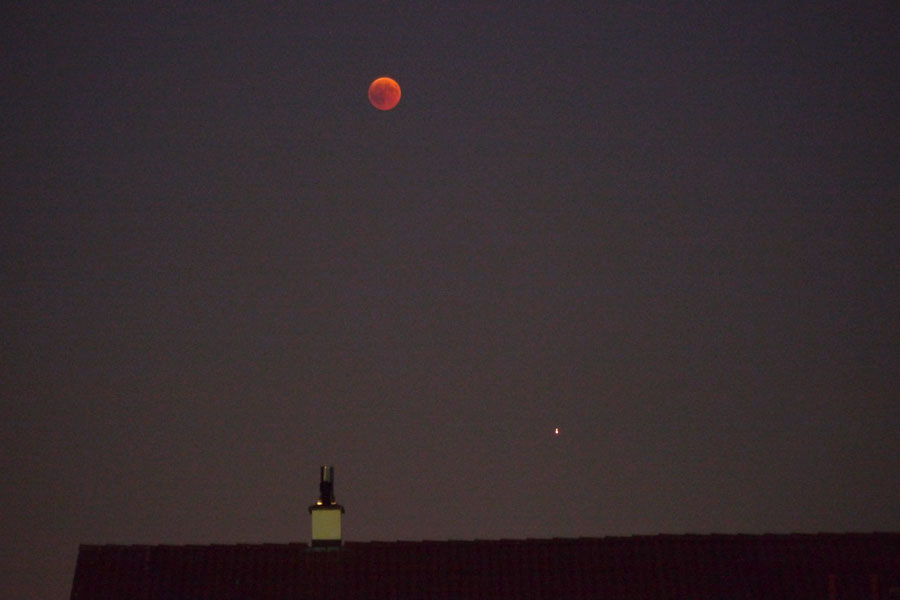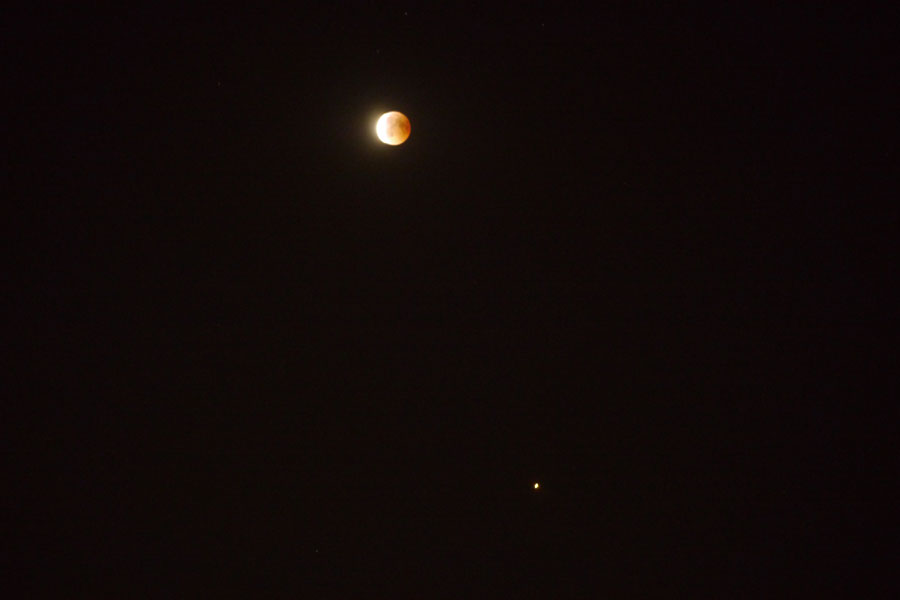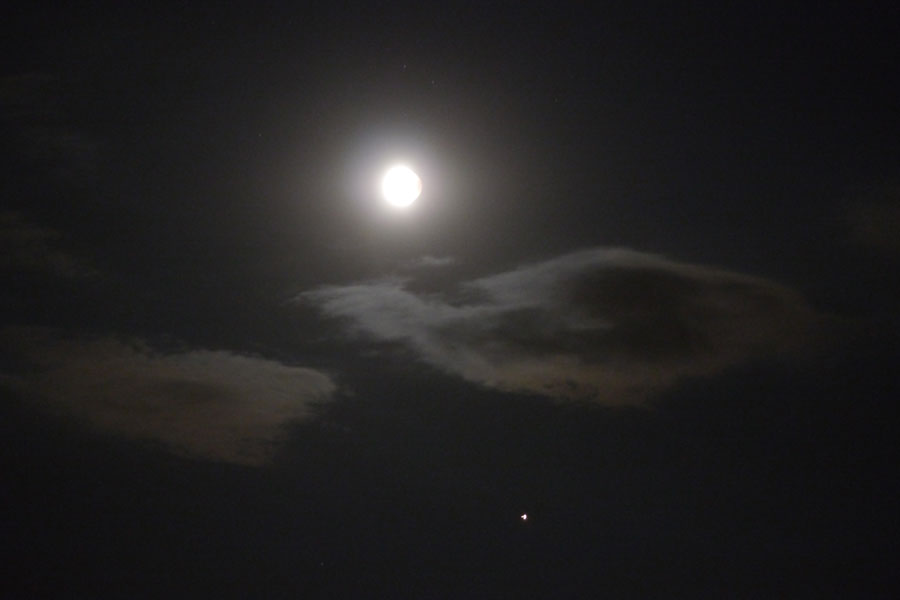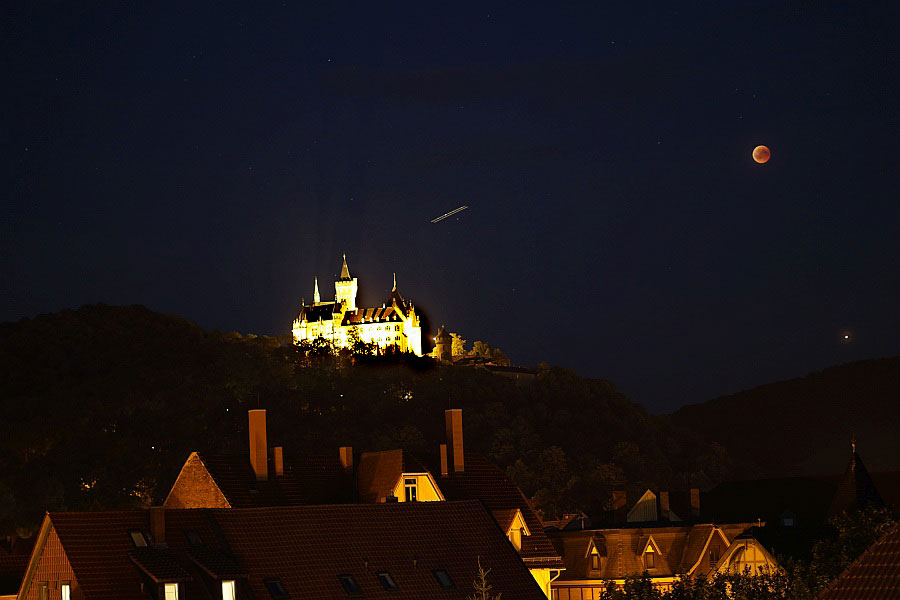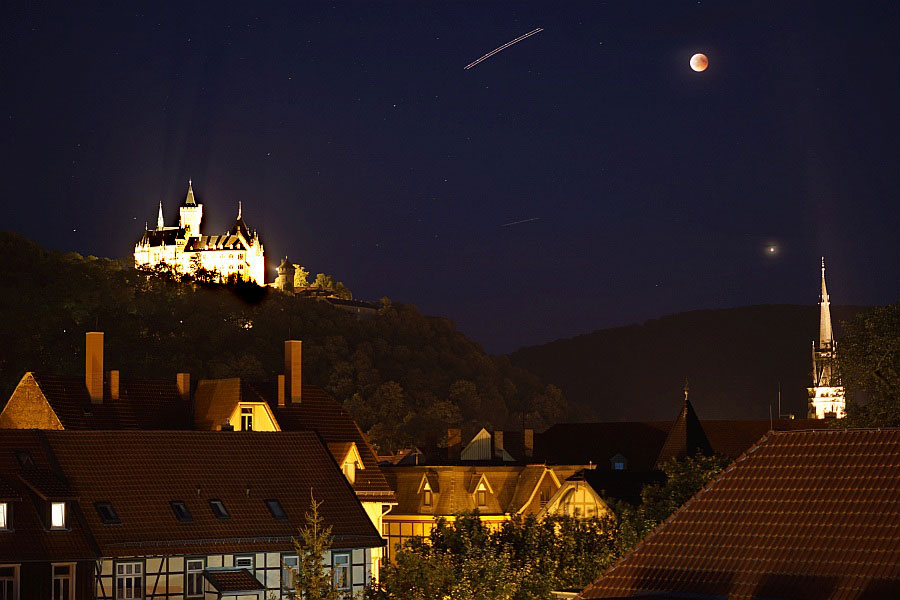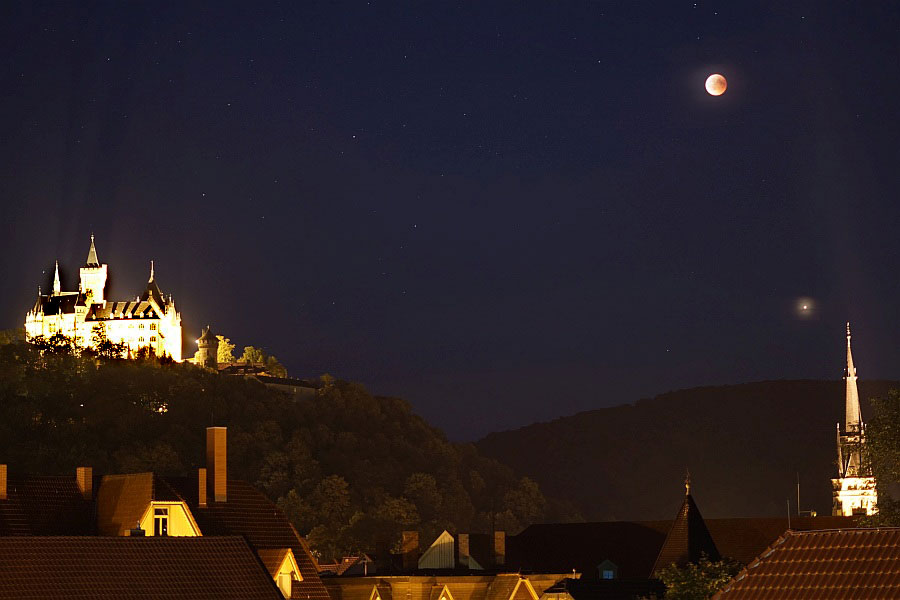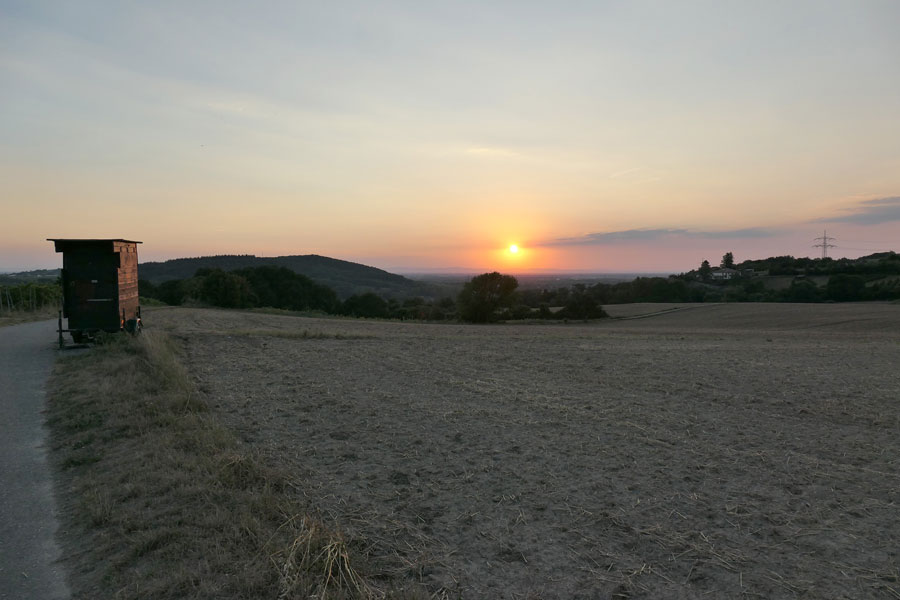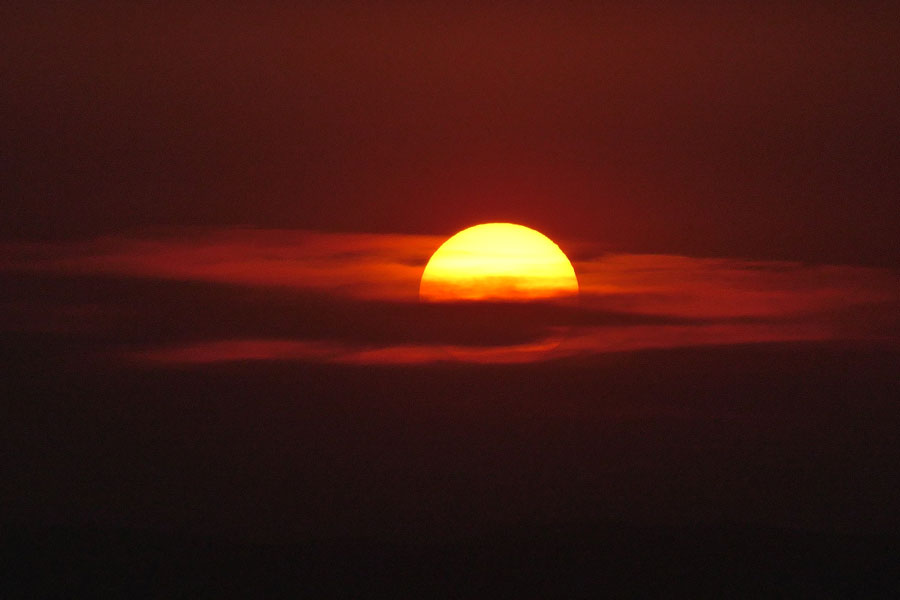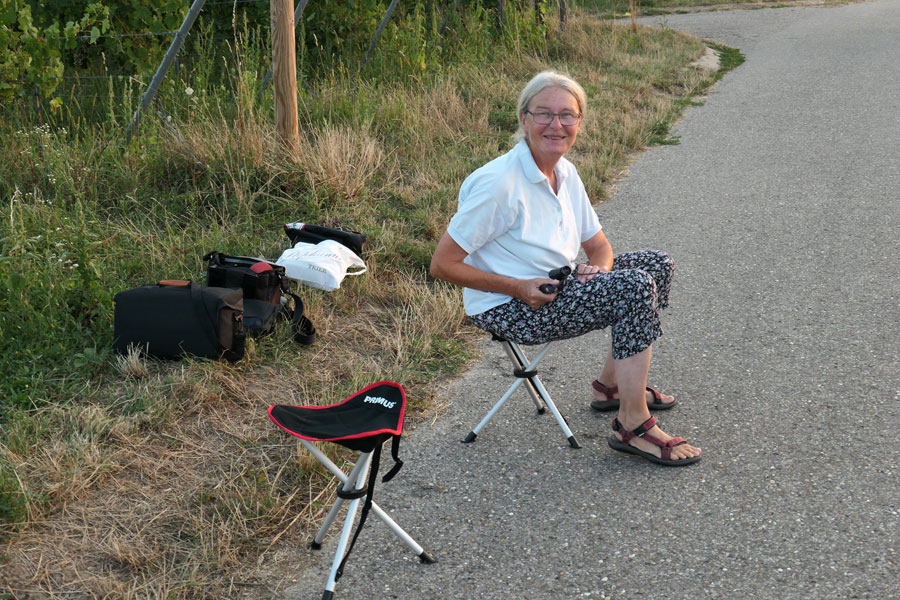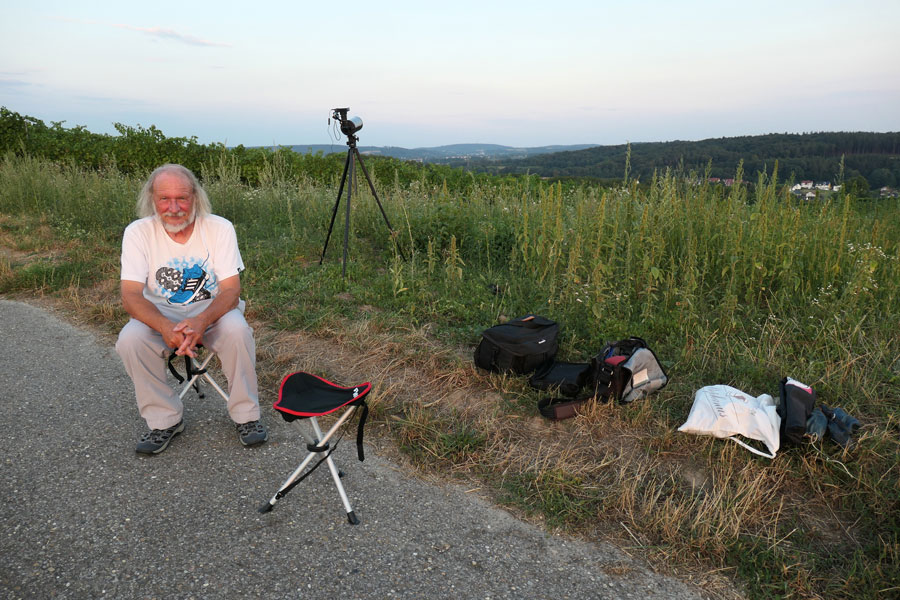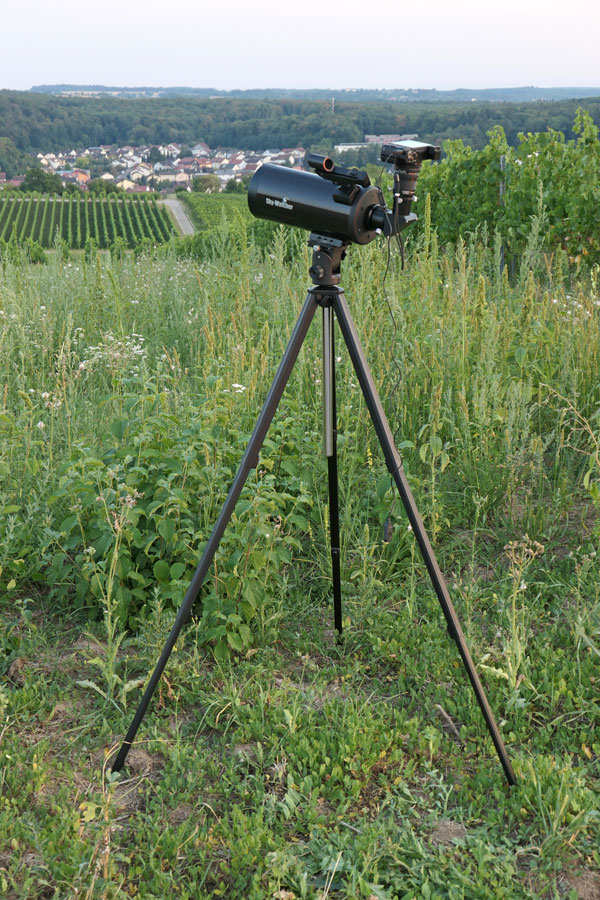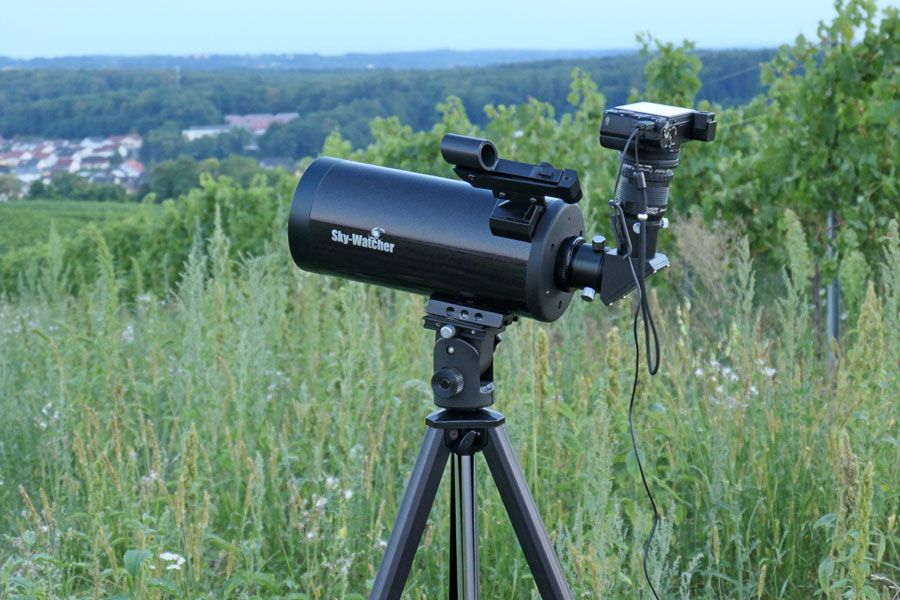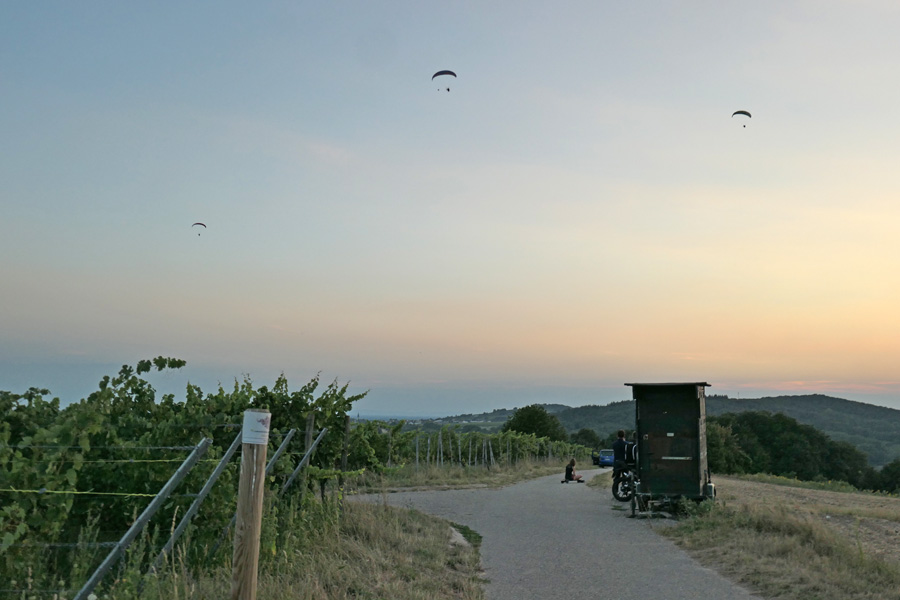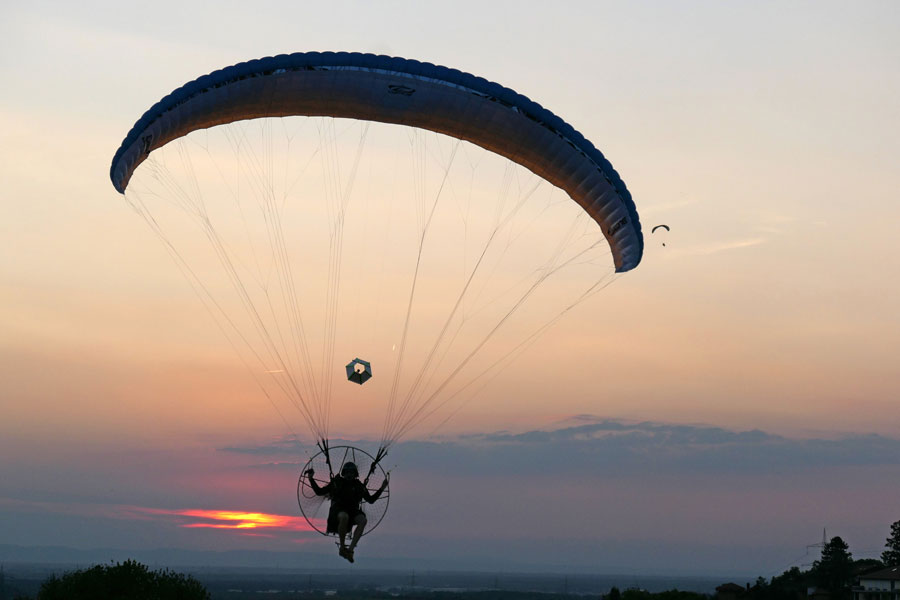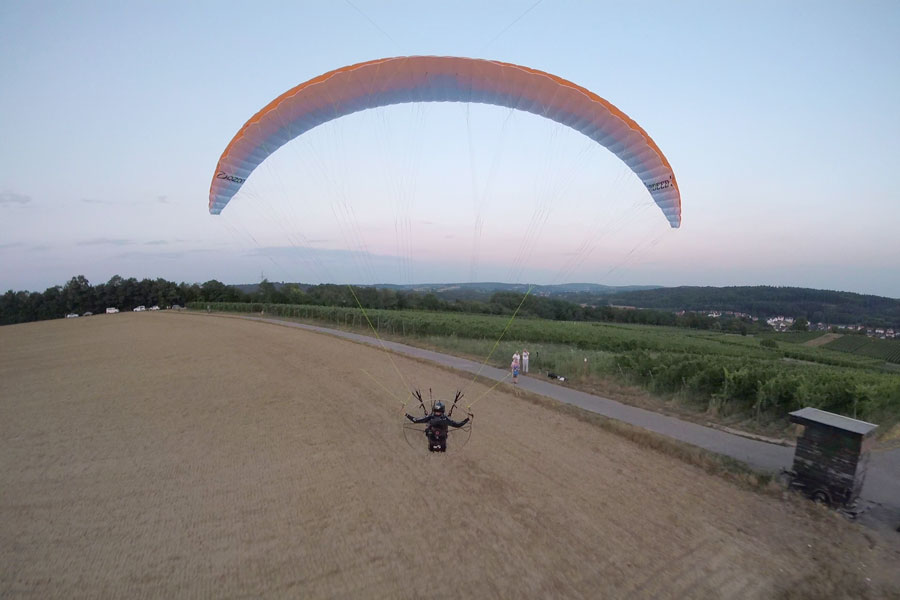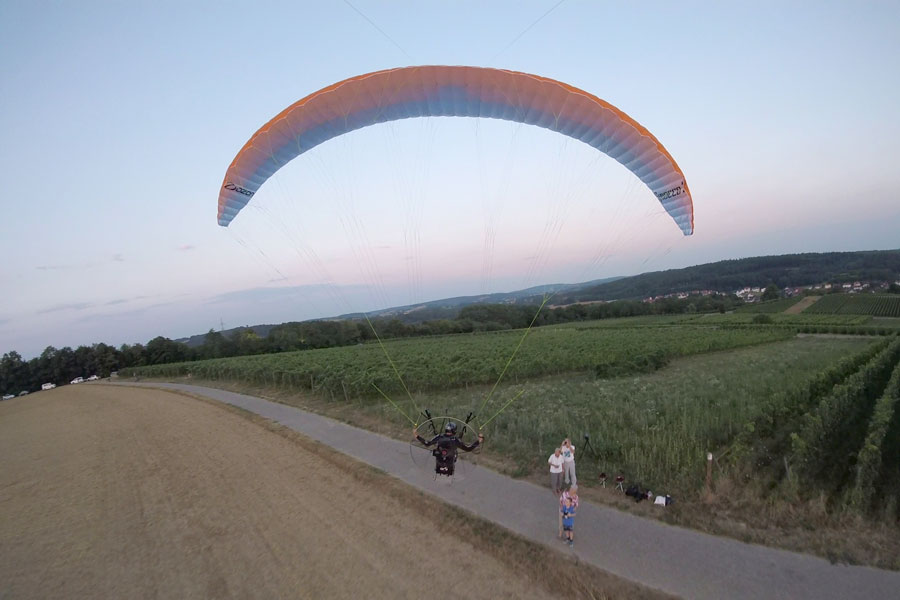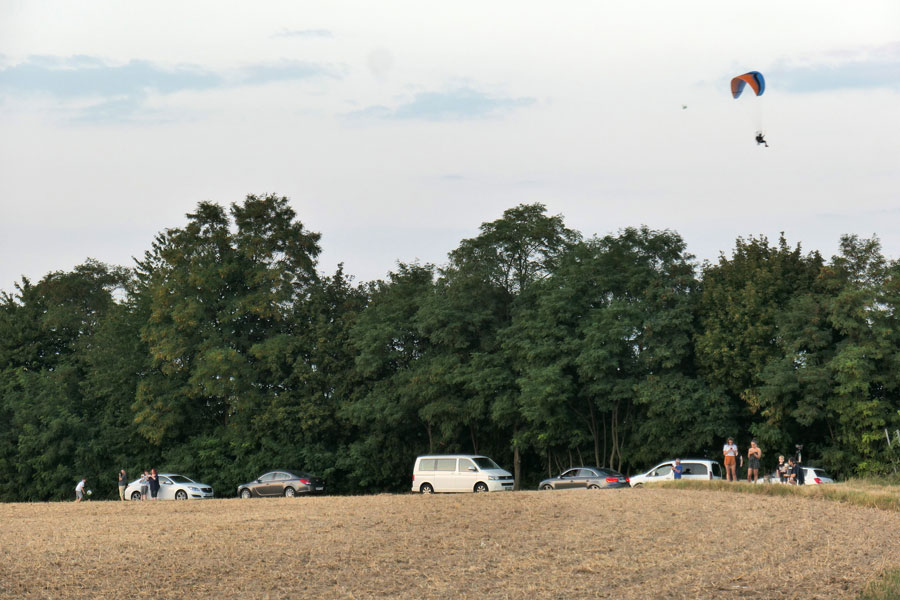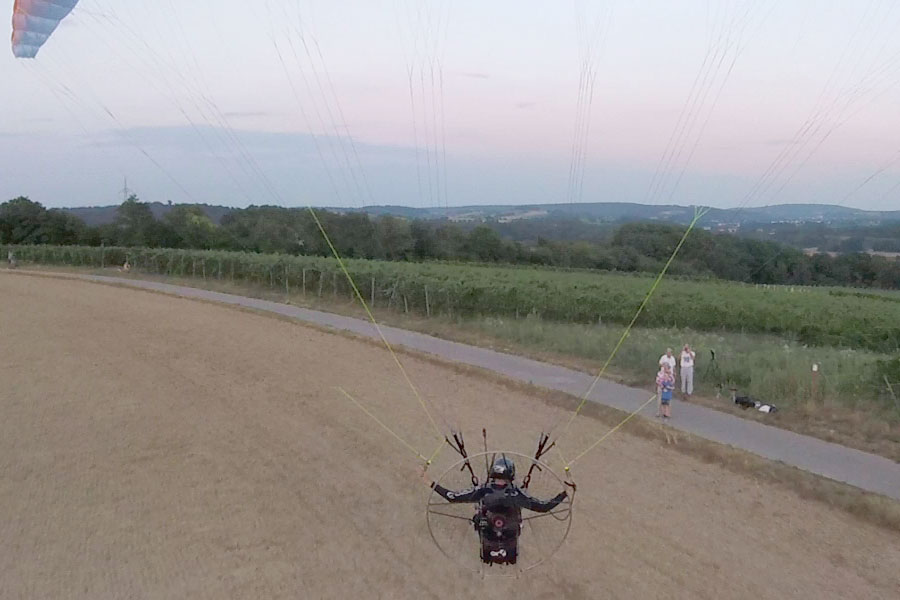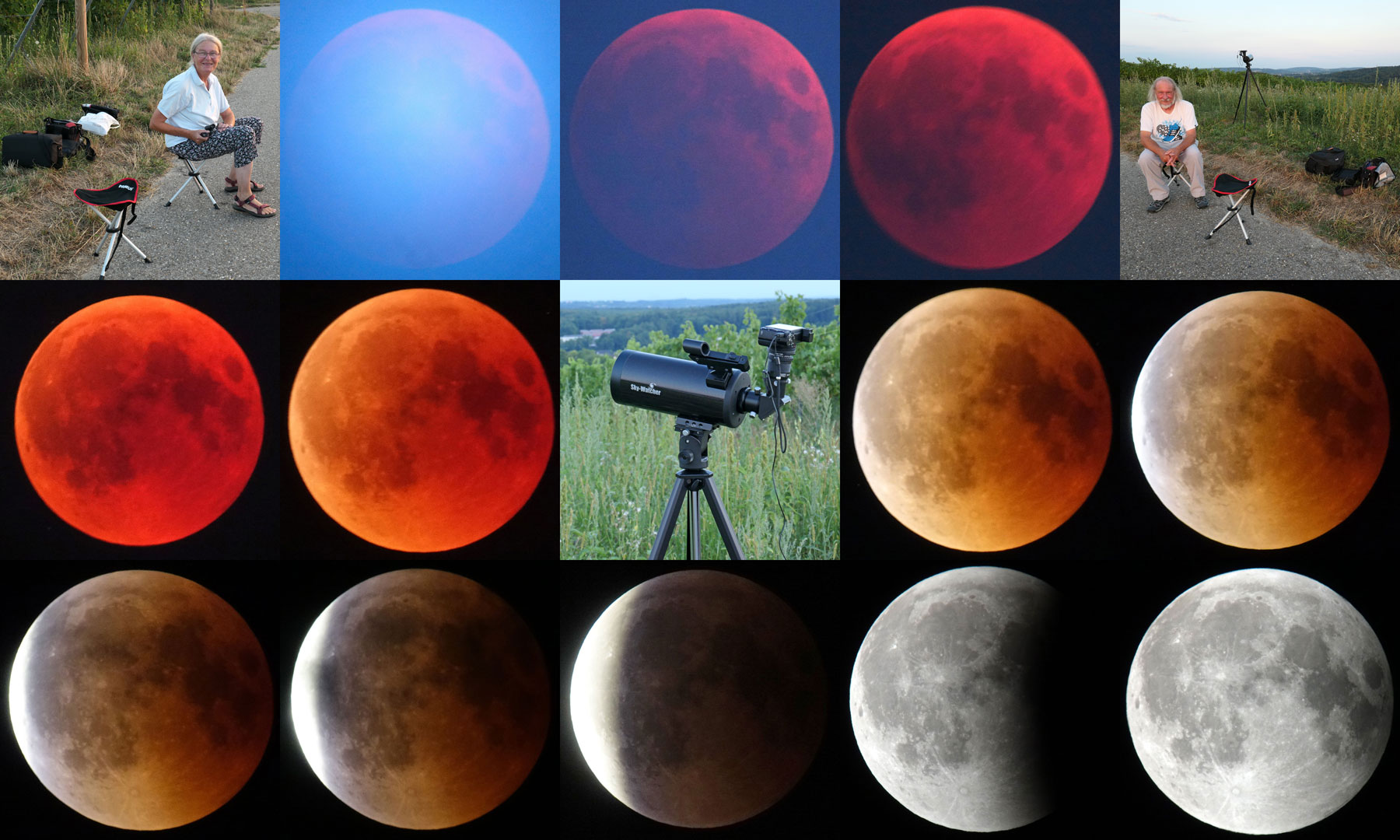Total Eclipse of the Moon 2018 (Blood Moon)
Introduction | Photos | Collage | Links
Introduction
On July 27, 2018, a total eclipse of the moon could be observed in Germany - provided that the sky was not coverd by clouds or that it was even raining. We observed and photographed the lunar eclipse (using the Sky-Watcher Skymax-102 with Sony RX100 M4 attached on a tripod and TS binoculars) on the Heiligenstein (a vineyard near Mühlhausen/Kraichgau). At the beginning, we were almost alone there, but in the course of time more and more people appeared, and until about the end of the totality phase there was a lot going on on the hill.
When we arrived on the Heiligenstein, it was still about the sun (a photographer took pictures of flowers against the sun, a couple enjoyed the sunset). But then it hid prematurely between clouds and everyone waited for the moon. Later, Mars, other planets, and some brighter stars appeared on the nightly sky. But before that, there were three paramotor pilots flying around, one of them came very close to us to greet us, a dog fight with a dog bite, and much more.
Unfortunately, there were clouds on the horizon (also on the side were the sun set), so that we were not able not observe the initial partial phase. Everyone had to wait until about 9:50 pm, when the total phase had already started, until the moon finally shimmered very weakly through the clouds on the horizon. I discovered the moon first, at least in our area, and many people had trouble finding the moon at all at the beginning. Later the moon was easier to see, but not really good for a long time.
Together with a photographer next to us, all the others were already gone, we stayed until about 11:30 pm, that is, until after the end of the totality phase, in order to observe how the light returned on the moon. I would not have paid that much attention to this and probably would have left earlier... Luckily we stayed - it was simply great to watch how the moon got brighter and brighter!
From a quarter to noon until almost 1 am, we stayed outside with a bottle of Prosecco and followed the partial phase until the moon was almost "whole" again (I took my last photo at half past twelve, we were in bed at 1 am; theoretically, the eclipse lasted until half past 1 am...). I took some more photos from the terrace, which strangely turned black and white, probably because the moon was shining bright again.
Regrettably, I forgot to take photos of the moon and Mars together, because I was too much focused on my telescope. Luckily, I received photos by a friend and my brother and include these below.
By the way, my large TS binoculars proved their worth when observing the moon, especially at the beginning, when you could not see anything using the small Leica binoculars.
Data (Germany; after n-tv, with my own additions/changes)
- 19:13 Uhr: The moon enters the Earth's penumbra
- 20:24 Uhr: The moon enters the Earth's umbra (beginning of the partial phase)
- 20:48 Uhr: Moonrise in München
- 20:56 Uhr: Moonrise in Ulm
- 20:57 Uhr: Moonrise in Berlin
- 21:04 Uhr: Moonrise in Mühlhausen/Kraichgau
- 21:07 Uhr: Moonrise in Frankfurt a. M.
- 21:30 Uhr: Beginning of totality
- 22:22 Uhr: Maximum eclipse
- 23:13 Uhr: End of totality
- 00:19 Uhr: The moon has left the earth's umbra (end of the partial phase)
- 01:30 Uhr: The moon has left the earth's penumbra
- 05:16 Uhr: Moonset in Ulm
- 05:18 Uhr: Moonset in Mühlhausen/Kraichgau
Remarks Taken from "Abenteuer Astronomie" (with my own additions/changes)
- The totality lasts from 21:30 to 23:13 CEST. At its end, the moon only stands between 10° and 18° high in the sky, depending on its location in the German-speaking world.
- When the moon touches the Earth's umbra at 20:24 CEST and the partial phase begins, it has not yet risen in the entire German-speaking area, but the sun is still in the sky.
- For locations further to the southeast, part of the partial phase can still be seen at moonrise. In Vienna (20:30 CEST) or Munich (21:00 CEST) the moon rises before the beginning of totality (21:30 CEST). This is also true for Ulm (20:56 CEST) and for Mühlhausen/Kraichgau (21:04 CEST).
- Thanks to the long totality, however, one will enjoy a completely eclipsed moon everywhere in the German-speaking area. The following partial phase, which ends at 0:19 CEST on 28 July, is all the better to admire on a higher moon and a darker sky.
Photos
From about the fourth photo on, the colors are quite "original," because I did not have to edit the photos that much anymore. At first, the moon was so faint that it could hardly be seen with the naked eye, and also not in the telescope. This got better over time, making photography a little easier.
Because I tried to focus the telescope using the camera's viewfinder, I produced many blurred photos because I could not find anything to focus on. When Mars appeared on the sky, a photographer next to us recommended that I use Mars as a focusing aid. That actually went somewhat better. Afterwards, I wondered why I did not figure this out myself...
If you click a thumb nail, a larger version of the image will appear in a new window. You have to close this new window manually!
The Total Eclipse of the Moon
My first photo of the "blood moon" or what my processing made of it (about 9:50 pm)! |
At about 11 pm you were able to see a little more of the moon (but most of my photos turned out blurry, because I was hardly able to see the moon in the viewfinder) |
At about 11:10 pm the moon could be seen as a whole (and my photos got even more blurry…) |
||
Changing my technique and magnifying less, the photos became a little better (shortly after 11:30 pm; perhaps I used already Mars as a focusing aid here...) |
At about 11:50 pm the lighting of the moon started to look "asymmetrical" (unevenly distributed) |
At about 11:05 pm, the sunlight started to invade the moon |
||
At about 11:15 pm the light became so bright, that the red color started to disappear |
Here, I already underexposed the moon in order to counterbalance the bright sun light and make details still visible (about 2 minutes later) |
At about 11:20 pm, the bright section almost already outshone the rest |
||
At 11:25 pm, it was so bright that I was only ably to brighten up the rest of the moon with the help of image processing; shortly after we returned home |
Back at home, from about 11:45 pm on, I only "got" fuzzy photos. Around midnight the photos became sharper again (and, strangely enough, black and white) |
And at about 0:30 am, the moon was already nearly "complete" |
||
Total Eclipse of the Moon, 07/27/2018 - Sony RX100 M4 |
||||
Moon and Mars (by Other Photographers)
Before the Total Eclipse of the Moon
Before the total eclipse of the moon - the sun was still shining when we arrived on the Heiligenstein... |
But soon after, the sun hid behind clouds (as did the rising moon) ... |
|
Astrid observing the sun and the Rine valley |
Gerd (me) and his telescope in the back (directed towards the moon) |
|
The telescope, a Sky-Watcher Skymax-102, on a simple tripod |
My Sony RX100 M4 was attached to the eyepiece; I also used a simple cable release for taking the shots |
|
All of a sudden, three paramotors were approaching... |
...coming closer and... |
|
...very close to greet us... |
...and to take photos of us - the box flying behind the pilot contained a camera! |
|
Regrettably we did not recognize the pilot, although he lives in our village... |
A lot of people had assembled on the Heiligenstein to watch the total eclipse of the moon |
|
Here are sections from the paramotor photos, made a little bit brighter |
||
Before the Total Eclipse of the Moon, 07/27/2018 - Panasonic TZ202 |
||
Collage
I created a collage from selected photos shown above:
Total Eclipse of the Moon, July 27, 2018
Links
- Rekord-Mondfinsternis mit Hindernissen (Abenteuer Astronomie): abenteuer-astronomie.de/rekord-mondfinsternis-mit-hindernissen (in German)
- Countdown zur Mondfinsternis läuft (n-tv): www.n-tv.de/wissen/Countdown-zur-Mondfinsternis-laeuft-article20548143.html (in German)
- Die Super-Mondfinsternis 2018 (Wolfgangs Gartensternwarte): wolfgangs-gartensternwarte.de/die-super-mondfinsternis-2018 (in German)
| 17.12.2019 |
